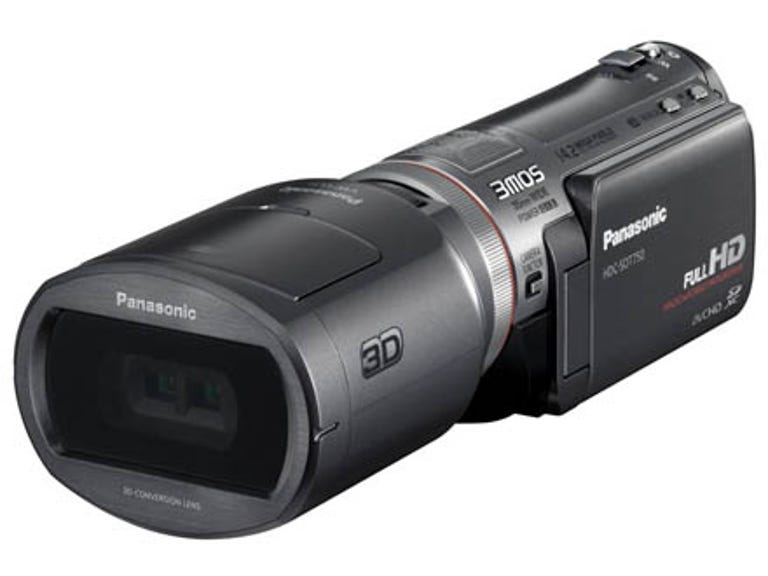 Why You Can Trust CNET
Why You Can Trust CNET Panasonic HDC-SDT750 review: Panasonic HDC-SDT750
The Panasonic HDC-SDT750 is an excellent 2D camcorder, with a host of useful, creative features -- most of which are lost when you opt to film in 3D. Thankfully, these limitations fail to undermine the novelty of lensing in the third dimension. If you have a 3D TV, it's probably worth the premium.
Panasonic has a new
vision for 3D, and it doesn't rely on the software industry or broadcast
community. Instead, the Japanese giant is giving us the tools to make our own
3D content. The upcoming Lumix DMC-GH2 Micro Four
Thirds snapper puts 3D into the hands of the photographic community, while the
Panasonic HDC-SDT750 reviewed here aims to have the You've Been Framed crowd shooting family
members falling into the third dimension. It's a canny strategy that
could ultimately change our attitude towards 3D. For £1300, you could own this 3D camcorder.
The Good
The Bad
The Bottom Line
A great 2D
camcorder at heart
The SDT750 looks much like any other high-end SD camcorder. It's light (just 375g) and extremely well featured. The 3-inch flip-out touchscreen is the main interface for setting the camera up. Opening it gives access to the card slot, power button and cable connectivity. The camcorder shoots on SD, SDHC and high-capacity SDXC cards. There's also 32GB of internal memory.

A high-performance 7,590,000-pixel (2,530,000 pixels x 3) 3MOS sensor delivers astoundingly good image fidelity for the form factor. It's extremely easy to tout around, and it even has 5.1 audio recording -- don't expect anything comparable to cinematic surround sound, though. You can take digital still images while recording video, or operate in a dedicated, 7.89-megapixel 'still picture' mode, with optical image stabiliser and face detection. An 'intelligent auto' mode takes care of the business end of shooting, while a selection of presets for specific scene types, such as portrait and scenery, add creative variety for the autopilot.
Just add 3D lens and shoot
While this is undoubtedly a juicy little shooter in 2D mode, that's not what concerns us. No sirree, Bob. What we're excited about is its 3D potential. Panasonic paved the way for stereoscopic camcordering with its prosumer model (yours for just £18,000), but this comes in much cheaper.
The key is a separate 3D conversion lens that threads (rather awkwardly) onto the camcorder. It's rather like bolting on a hideously overweight filter. Interestingly, in Japan, the VW-CLT1 lens is being sold as an optional add-on. Here in the UK, it's all part of the package.
The conversion lens cap itself acts as an alignment tool, and you'll need to adjust this each time you attach the lens. The process only takes a minute or two and involves tweaking vertical and horizontal lines on the touchscreen. Once the twinned optics are correctly aligned (an essential process), you're away. And that's literally it.
You get 3D… but nothing else
It should be noted that, with the 3D converter engaged, the zoom is disabled. This is not necessarily a bad thing as it prevents overeager cinematographers from zooming back and forth simply because they can. Unfortunately, a whole host of other creative tools are also benched in 3D mode, including the zoom mic, 'intelligent auto' mode and face recognition. This could be construed as a little restrictive.
The camera shoots in the side-by-side 3D format, much like Sky 3D, so it's not Full HD. But images are sharp enough, and the 3D effect itself can be really spectacular. Careful composition is the key to creating engaging 3D footage -- flowers positioned a metre or less from the lens, for example, provide an effective forward-facing focal plane, with the background stretching into the distance. Without the subject really close to the glass, the dimensional effect is diminished. For everyday family shooting, this works really well. Shoot someone in close-up and they'll pop out of the frame.
3D playback is a cinch. We simply popped the SD card into a Panasonic P46VT20 3D plasma and it automatically recognised the AVCHD 3D file. A simple remote control is supplied to make file selection easier. If you don't have a TV with an SD card reader, you'll need to hook the camcorder up to your 3D TV using an HDMI cable.
As you amass your 3D files, you will need to edit them, not least because the audio falls out significantly between shots. Quite how easy it is to edit within the 3D format remains to be seen.
Conclusion
The Panasonic HDC-SDT750 is a superior HD camcorder in its own right -- one that probably warrants a five-star rating as is. However, the ability to shoot in 3D is a major embellishment. You'll pay a high price for the novelty, but surely the ability to catch the kids in 3D while they're still young enough to toddle around is compensation enough.
Edited by Emma Bayly
